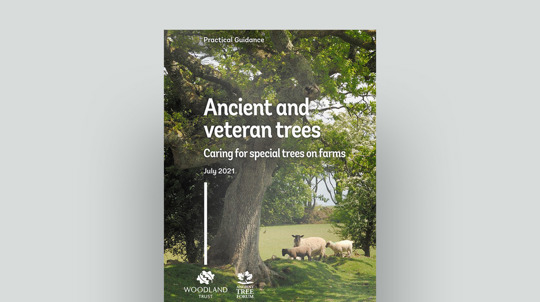Creating a basic work programme
Here are the main tasks and considerations for each stage of your wood's lifetime.
When working in the woods, always be mindful of wildlife like nesting birds, bats, dormice and other animals and take care not to damage other woodland plants. Beware of soil erosion and run-off if the work causes any ground disturbance.
1-3 years
Tell people where they are
Make sure everyone involved in maintaining the space knows where trees are planted to avoid mowing or accidental damage.
Replace failed trees
Some loss should be expected on most sites, especially if you’ve chosen not to use tree protection or fencing. Base decisions to replace lost trees (usually within the first 2-3 years) on observation of the site, and take care not to use unnecessary resources replanting areas which seem unsuitable. Accepting some loss will contribute to a structurally diverse and interesting woodland.
Check tree guards
If you’ve chosen to use individual tree guards, check them regularly in the first few years. Strong winds can blow trees over so make sure guards, canes or stakes are upright and pushed firmly into the soil. Pull up any grass growing inside the guard and carefully replace the guard. Check tree stems and guards for animal damage too. Keeping tree guards firmly pressed into the soil and a weed-free area around your trees will help.
Weed regularly
Weeding is the most important step in giving your trees the right start. Keep a 1 metre diameter around the tree clear of weeds and grass for the first 2-3 years to reduce competition for moisture and nutrients. You can suppress weeds with mulch, such as bark chips or straw bales. Apply to a depth of around 10cm to prevent it being blown away or dispersed and top it up annually. You can also buy mulch mats and peg them into the ground to keep them in place. We recommend using alternative methods of vegetation control and avoiding herbicides wherever possible, especially near semi-natural habitats or where people use the site often. If you think there is no alternative, follow best practice guidelines using trained operators.
Avoid mowing
Regular mowing is not advised as it invigorates grass growth and increases competition for moisture. If you do want to mow, take care to avoid damaging the trees and guards.
Water if necessary
Your trees will adapt to conditions at your site so watering shouldn’t be necessary, but if there’s a particularly long dry spell and you feel it’s necessary, saturate the ground thoroughly to make sure water soaks deep into the soil.
Monitor tree health
Depending on species, a variety of common diseases may affect your trees, but they rarely kill young ones. A cold winter may cause frost damage but trees should recover. Our blog covers common disease symptoms but if concerned, do get in touch with us for advice.
3-10 years
Remove tree protection
If you’ve used it, remove individual tree protection as soon as trees are well established and beyond the reach of most herbivores. Protection can start to split and disintegrate after 5-10 years and may hamper growth beyond this point if not removed. A Stanley knife with a hooked carpet fitter’s blade is the best tool for opening tubes without damaging trees. Remove the tubes in the summer to allow the bark to toughen while animals like rabbits have plenty of grass to eat.
After removing, re-use or recycle your guards wherever possible. Responsible disposal is vital to protect wildlife and the environment. Check with your local authority or contact a recycling specialist.
Establish richer communities
Woodlands are much more than groups of trees. Think about the wider communities of flora, fungi and fauna which may make a home in your developing woodland ecosystem. Many will arrive naturally, but some can need a bit of help. Consider adding nest boxes for birds, bats, and small mammals. Create a pond, or plant a mix of grasses and wildflowers in an open area. Remember that open spaces need managing to keep them clear.
Promote diverse structure
Small-scale re-spacing interventions may be appropriate early in the establishment phase. For example, consider cutting to give space for selected trees such as oak or rowan among a thicket of birch (which tends to grow faster). This intervention can help promote tree species diversity.
Begin cutting programmes
Read our detailed advice on how and when to carry out coppicing, pollarding, formative pruning and thinning.






